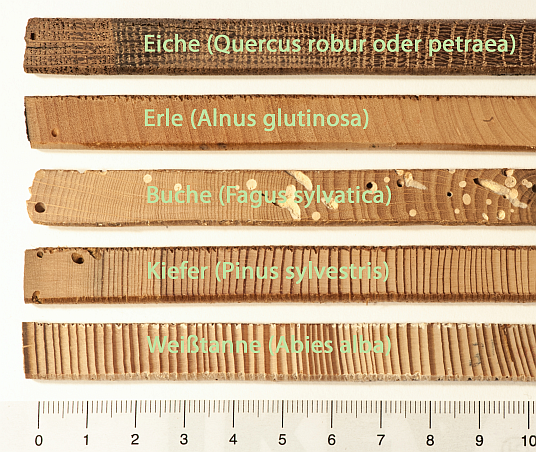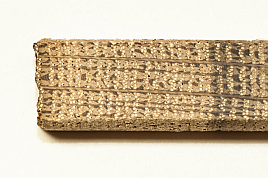Heartwood, sapwood, wane
In central Europe four species of trees prevail in utilization for house building: Oak, spruce, fir and pine. Two of these, oak and pine, show a difference between a darker heartwood and a brighter sapwood part. In the case of spruce and fir heartwood and sapwood may not be distinguished from each other.
For a dating to the exact year the sample must be preserved entirely, up to the transition from sapwood to bark which is the “wane”. In special cases even the season the tree was cut may be determined. Although trees were usually cut in the winter there are exceptions and these exceptions are not as scarce as often assumed. If a tree was cut in the winter, the last annual ring has been built fully up to the dense late wood. If the wane is missing or even parts of the sapwood, the year of felling may only be estimated with the help of so called sapwood statistics. It may be deduced from this statistics that the average amount of sapwood rings of oak trees is about 15 to 20 annual rings. Extreme deviations do not occur often but still may occur. Other species of trees show a totally different behavior in the ratio of heartwood to sapwood. Pinewood for instance builds an average of 40 to 60 sapwood rings with an enormous margin of fluctuations. Generally the missing amount of sapwood rings will be added mathematically. The rule for oak wood is as follows: Last heartwood ring remaining + 20. For this is an estimation, the mathematically determined year of felling is completed by an interval. The entire dating information would be: Year the tree was cut ± 6.

In the case of pine it isn't possible to estimate missing rings like with oak because of the great splay in the amount of sapwood. Samples from pine missing sapwood and wane would be dated with the comment “after…” referring to the last preserved annual ring. As is the case with spruce and fir the heartwood may not be distinguished from sapwood. Here wane must be preserved if the sample should be dated to the exact year. While oak, spruce and fir build an annual ring for each year, pine trees sometimes do not built one. A sample affected by this, cannot be dated at all, except the missing ring is known in the pinewood calendar and has been determined before.
Oak, spruce and fir do build an annual ring within every year of their life, whereas the situation with pine is different. Under specific conditions pine appears to not build an annual ring. If this happens, the sample will only be datable if this "missing ring" has already been proved with other samples stemming from the same region and if the gap has been considered within the setup of the calendar.







